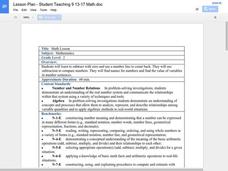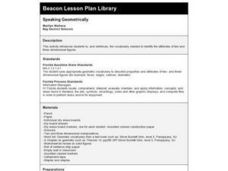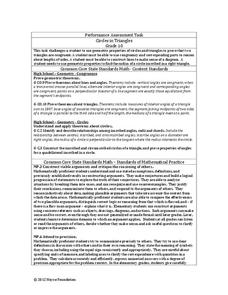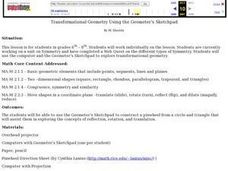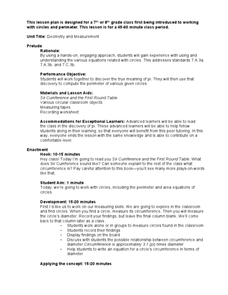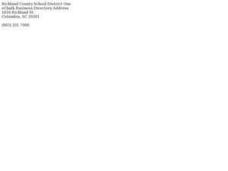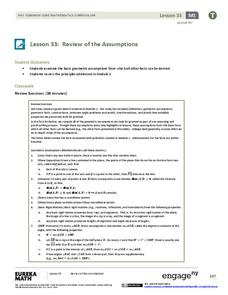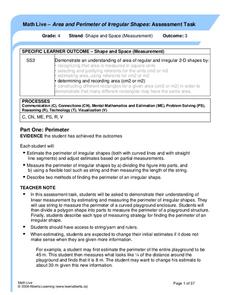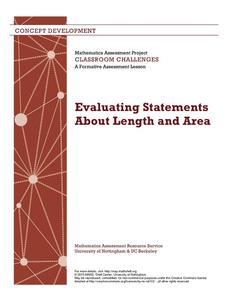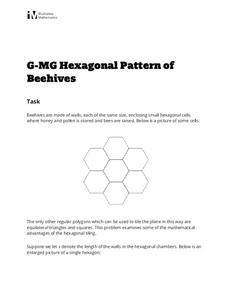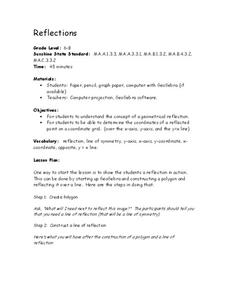Curated OER
Number Line Math
Second graders use a number line to practice subtraction. For this subtraction lesson, 2nd graders use a number line to count backwards. Students participate in mad math activities and solve problems.
Curated OER
Speaking Geometrically
Fourth graders are introduced to the vocabulary needed to identify the attributes of two and three-dimensional figures. They work together to create a word wall, which contains the geometric terminology being learned.
Inside Mathematics
Circles in Triangles
Challenge the class with inscribed circles in triangles. The assessment task requests class members use their knowledge of circles and right triangles to prove two triangles are congruent. They go on to utilize their knowledge of...
K6 Math
Nets and 3-Dimensional Figures
Three solid figures are lined up down the left side of the page to be compared to three nets down the right side. Learners simply decide if the corresponding net matches the solid figure. Be aware that the publisher's watermark is...
Curated OER
Pop-it...Stop-it
Students observe how certain geometric shapes can be used to make some structures rigid and others flexible. The activity involves construction of a 30-60 right triangle, folding while following directions, and identifying polygons.
Curated OER
Slope & Rate of Change
This short handout addresses the concept of slope in two different ways: geometrically and analytically. Start with a brief description of slope, then use graphical representations to compare positive vs. negative slope and zero vs....
Alabama Learning Exchange
Origami Geometry
Origami is an excellent way to combine Japanese culture, art, and geometric shapes into one engaging instructional activity! Scholars begin by listening to the story Sadako and the Thousand Paper Cranes and learn the origin of...
Curated OER
Transformational Geometry Using the Geometer's Sketchpad
Students complete a webquest on the various types of symmetry. Using a computer, they explore the concepts of transformational geometry and identify points, segments, lines and planes. They experiment with the rotation of a quadrilateral...
Curated OER
Parallel-o-Home
Students investigate the usage of parallel and perpendicular shapes in the real world. In this geometry lesson, students investigate shapes for properties that are related to the real world. They relate all the properties of shape tot he...
Curated OER
The Shape of Things
Students create shape booklets. In this interdisciplinary instructional activity, students practice shape recognition as they participate in a scavenger hunt and create a shape booklet.
Curated OER
Midpoint
In this midpoint activity, 7th graders solve 30 different problems related to determining the midpoint in a series of numbers. First, they identify and construct basic elements of various geometric figures. Then, students determine the...
Curated OER
Compass Rose
Students describe the movement of the Earth as it relates to the sun. They construct a permanent compass rose and use it to find directions.
Curated OER
Geometry and Measurement
Students view a right triangle displayed by the teacher. Students measure legs and the interior angles of the triangle. They look for a pattern or relationship between the legs and angles. Students use pegboards and string to create more...
Curated OER
Classifying and Constructing Corners
Fifth graders, after seeing Honeycomb examples, complete a Classifying Angles worksheet, Clock worksheet, and Defining Angles worksheet.
Curated OER
What Pie?
Students practice making and interpreting pie graphs so they are better able to decide if a pie chart is the appropriate form of display. Students examine included overheads of different pie charts, and directions on how to make pie...
Curated OER
Measure the Angle
Students measure angles. In this angle lesson plan, students draw angles. They use a protractor to measure angles and identify the angle as straight, right, acute, or obtuse.
Curated OER
How To Use A Protractor
Fifth graders use the SMART Board to demonstrate how to use a protractor to measure acute, obtuse, and right angles. In this protractor lesson plan, 5th graders also complete an angles worksheet.
EngageNY
Review of the Assumptions (part 1)
What was the property again? Tired of hearing this from your pupils? Use this table to organize properties studied and as a reference tool for individuals. Learners apply each property in the third column of the table to ensure their...
Alberta Learning
Area and Perimeter of Irregular Shapes
Evaluate young mathematicians' understanding of area and perimeter with this series of three assessment tasks. Challenging students to not only calculate the area and perimeter of irregular shapes, but to explain in writing their...
Mathematics Assessment Project
Inscribing and Circumscribing Right Triangles
High schoolers attempt an assessment task requiring them to find the radii of inscribed and circumscribed circles of a right triangle with given dimensions. They then evaluate provided sample responses to consider how to improve...
Mathematics Assessment Project
Evaluating Statements About Length and Area
Class members complete an assessment task by identifying whether statements about triangles and quadrilaterals are always true, sometimes true, or never true. They then participate in a sorting activity with the same objective.
Illustrative Mathematics
Hexagonal Pattern of Beehives
Young geometers and biologists investigate the math of nature in an activity that is just the bee's knees. Participants will study the tessellations of hexagons in a beehive, along with the natural rationale behind the specific shape....
Curated OER
Reflections
Tenth graders perform reflections on different geometric shapes. In this geometry worksheet,students define the concept of geometric reflections and find the coordinates of the reflection on a coordinate grid.
Curated OER
Preparation and Transition to Two-Column Proofs
Students investigate proofs used to solve geometric problems. In this geometry lesson plan, students read about the history behind early geometry and learn how to write proofs correctly using two columns. The define terminology valuable...
